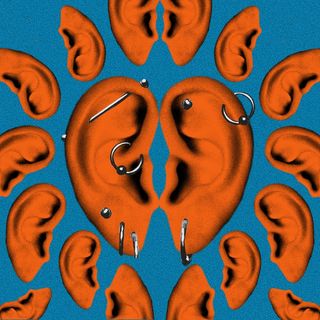.png?rect=0,250,4000,4000&w=320&h=320&fit=min&auto=format)
India's Tribal Communities Are Plagued By Sickle Cell Disease, and the Government Is Failing Them
Pargi, from the Bhil community, was hospitalized 50 times due to sickle cell disease. When he tried to tell the government about its prevalence, nobody listened.

“I used to wonder why the medicines were not working. The pain would just not go away.”
Ever since Lalit Pargi was born, he would frequently fall sick. Although his parents would take him to various hospitals for treatment of the short-term symptoms like fever and cold, he never seemed to get better. It wasn’t until he was 16 that he was finally diagnosed with sickle cell disease. Till then, Pargi says he “was simply bearing the pain.”
Sickle cell disease (SCD) is believed to be one of the most widespread inherited disorders that can be life-threatening. In India, over 1.4 million people suffer from this condition, but it receives shockingly inadequate attention from the government. One of the primary reasons for this is that the disease predominantly impacts India’s impoverished tribal communities.
The 2011 census states that 8.6% of the total Indian population belongs to tribal groups. Among them, around 1 in 86 babies are born with SCD. Often living far from development, the tribal population of India is largely characterized by social, educational, and economic disadvantages that set them apart from other communities and make them especially vulnerable to this debilitating disease.
What is Sickle Cell Disease, and Why Are Indian Tribals Suffering?
SCD is a genetically inherited, chronic medical condition that affects the red blood cells – and therefore the hemoglobin – in the blood. While a healthy person has disc-shaped red blood cells, in SCD, these cells take on a crescent or "sickle" shape. This results in a range of complications such as strokes, vision issues, infections, and bouts of intense pain.
When it comes to disorders affecting the red blood cells, “the commonest is sickle cell disease. It is a huge burden across the globe,” says Dr. Gaurav Kharya, clinical lead, Centre for Bone Marrow Transplant and Cellular Therapy, Indraprastha Apollo Hospital, New Delhi.
Dr. Kharya explains SCD might not cause a problem routinely. However, the symptoms worsen when the weather is hot and a person gets dehydrated or in extremely cold weather when the small blood vessels get constricted. In remote tribal areas, where clean drinking water is scarce, SCD is thus exacerbated.
Limited access to healthcare and inadequate nutrition further worsen the impact of SCD, making it even more difficult for tribal communities to manage the disease effectively.
Moreover, substandard healthcare infrastructure in these regions often leads to the misdiagnosis of SCD. Patients seek help from local healthcare providers who address the symptoms, failing to detect the underlying condition. “The disease has multiple symptoms. For example, some people may develop yellowing of the eyes, leading many doctors to think of it as jaundice and treat it as such. Recurrent infections are also common, which are often mistaken for pneumonia or fever," explains Pargi.
34-year-old Pargi belongs to the largest tribal group in Rajasthan, the Bhils. During the initial stages of the disease, Pargi was locally treated for jaundice because of the paleness in his eyes. Whenever he went to the doctor complaining of fever, he was sent away with a painkiller.
“My family had no other way. They tried everything from consulting different doctors to even relying on superstitious practices. My hands and legs used to stiffen up. They used to think it was because of some god or goddess. It is common among the tribal population,” he says.
How treating SCD further marginalized tribes
Gautam Dongre, Secretary of the National Alliance of Sickle Cell Organisations (NASCO) India, emphasizes the seriousness of this disease, saying, "It can greatly affect people's lives, that's why timely treatment is crucial. Without proper diagnosis, someone with this disease might not live beyond 3–4 years. Even if they survive, they could face organ damage within 15–20 years. Their joints may stop working properly, leading to disability. Without the right treatment, it can result in early death. Otherwise, their entire life may revolve around going back and forth between the hospital and home."
The lack of diagnostic tests and communication from doctors becomes a critical issue for patients seeking timely treatment. Institutional neglect perpetuates a cycle of insufficient support and understanding for SCD patients, resulting in delayed care for many patients.
Even when patients are correctly diagnosed, SCD treatment is most often not accessible for them. “The cure is by bone marrow transplant. Another way of reducing mortality is gene therapy, which is currently being researched,” according to Dr Kharya. However, bone marrow or stem cell transplants are highly risky and could also lead to death. In addition, bone marrow transplant is an expensive treatment, ranging between Rs. 15–40 lakh.
Between 2005 and 2011, Pargi was hospitalized around 45–50 times and required ventilator support at least four times. “My family is educated. My grandfather was a BDO, and my father was also in government service. That's why I could afford a private hospital. Otherwise, it is not at all possible for someone to get treatment without a lot of money. Most of the tribal population cannot even afford to eat food properly,” he says. Thus, diagnostic tests costing around Rs, 4000 each are far beyond the means of most.
Pargi recounts that, in the course of his treatment, the savings of his father and other relatives were exhausted. The hospital bill was consistently between Rs. 1–1.5 lakhs. “I was always grappling with the question of how we will arrange the money needed to save me.”
To make matters worse, Pargi’s career was jeopardized by the disease. While in school, he would need to be constantly taken to the hospital due to the severe pain. The vicious cycle of the disease and the pain eventually led to him being depressed for 7 years.
What is the state doing?
The challenges in diagnosing and treating SCD are indicative of broader systemic issues within the healthcare system. These include huge gaps in education and awareness, allocation of resources, economic disparities, and poor policy-making.
There is a notable lack of programmes for managing SCD. The few government interventions that do exist do not reach far-off remote tribal communities.
Data from the Ministry of Health and Family Welfare reveals that from 2020–23, there has been a consistent gap between the approved budget for tackling SCDs and how much money is being expended on ground. For instance, in Madhya Pradesh, the approved budget in this period was Rs. 9525 lakh; however, the state only spent around Rs. 6238 lakh. That is, a significant portion of the approved budget remains unutilized. This budgetary gap points towards misallocation of resources on the state level.
Another major problem is the ignorance and apathy of government officials. “When I visited the National Health Mission blood cell division in Rajasthan, I was told there were no recorded cases of SCD in the region. I contested this, providing them with a list of 50 afflicted children. Despite this, they remained unresponsive,” recounts Pargi.
The devastating link between SCD and Malaria
While talking about SCD, one of the most critical aspects is its connection with malaria. “The epistemology of SCD is that it originates from the protective mechanism against malaria. People in areas endemic to malaria develop this genetic mutation to develop some defense against malaria,” explains Dr. Kharya. Essentially, the shape of sickle cells is not conducive for malarial parasites to survive.
There is a significant overlap between states that have higher tribal populations and states with a high concentration of malaria cases, including states such as Madhya Pradesh, Maharashtra, and Rajasthan. Such areas thus also fall in the sickle cell belt of the country, Dr. Kharya further explains. This places added strain on the communities susceptible to increased health risks and weaker immunity. Additionally, it overwhelms the limited healthcare infrastructure, leading to a cycle of health disparities.
Owing to being passed through generations, SCD has now become a hereditary disease. Further, SCD is a greater burden for communities with higher rates of endogamy. “There are more than 20 million carriers of the sickle gene, and 50,000 new cases of sickle cell disease are born in India every year,” Dongre states. “It has been forwarded through generations. Now, because of globalization, it is just one world. There has been a lot of movement around the globe. That’s why you can see SCD patients all around the world.”
Pargi shares that his parents carried sickle cell traits but remained asymptomatic, which is why they did not realize they had it. When a person has a sickle cell trait, it means they have inherited one sickle cell gene and one normal gene. People with SCT don't usually experience any SCD symptoms, but they can pass it on to their children. This lack of awareness about the disease is not limited to Pargi’s parents and is widespread in tribal communities throughout the country.
Early screening and detection of SCD can significantly reduce the risks associated with the disease. “In my village, there is still no provision for treatment or educating people about SCD. People have to travel to Udaipur for medical attention. I go there to camp and inform the tribal groups about this, hoping one day things would change,” says Pargi.
While the burden of SCD is higher among the tribal communities, it is not absent in other groups. Dongre, for instance, recalls that in Maharashtra, it is present in scheduled caste people, in Chattisgarh, it affects OBCs, and in Gujarat, it can be seen more in Patels and Parmars. Yet, the largest proportion of those affected are from the tribal population of the country, making up about 40% of cases.
However, Pargi says that there is a positive shift occurring. For instance, the introduction of newborn screening. With this development, as soon as a baby is born, one can test and identify SCD quickly.
Today, Pargi has dedicated his life to spreading awareness of SCD. He is a nursing officer at the Centre of Excellence for Sickle Cell Disease and an executive member of NASCO. “When I completed my nursing, I overcame my depression and started working towards spreading awareness.” Compared to when he was first diagnosed, he believes that awareness is certainly increasing.
Nuzhat Khan is an independent journalist and a student of M.A. Convergent Journalism at A.J.K Mass Communication Research Centre, Jamia Millia Islamia, New Delhi. Shaba Manzoor is an independent journalist. Her stories explore the intersection of society, culture, and gender.
Related
.png?rect=0,250,4000,4000&w=320&h=320&fit=min&auto=format)

TMI: People Tell Us About a Harmless Turn-On They Prefer to Keep Secret
